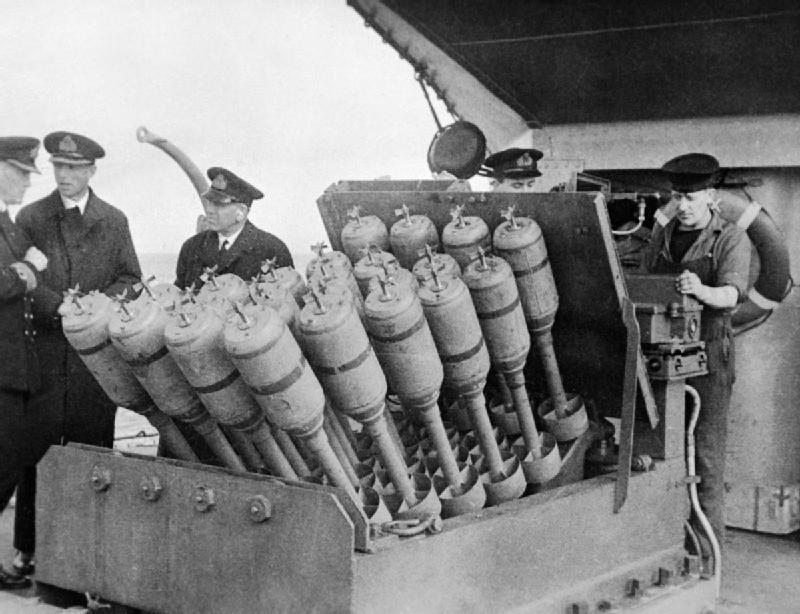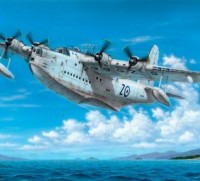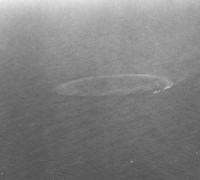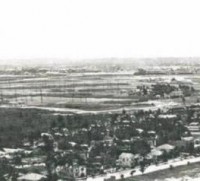- ANTI SUBMARINE TACTICS
4)HEDGEHOG

Anti-Submarine Weapons: Hedgehog, a 24 barrelled anti-submarine mortar mounted on the forecastle of HMS Westcott.
Photo.https://en.wikipedia.org/wiki/Hedgehog_(weapon)#/media/File:Hedgehog_anti-submarine_mortar.jpg
The Hedgehog (also known as an Anti-Submarine Projector) was a forward-throwinganti-submarine weapon that was used during the Battle of the Atlantic in the Second World War. The device, which was developed by the Royal Navy, fired up to 24 spigot mortars ahead of a ship when attacking a U-boat. It was deployed on convoyescort warships such as destroyers and corvettes to supplement the depth charges.
As the mortar projectiles employed contact fuzes rather than time or barometric (depth) fuzes, detonation occurred directly against a hard surface such as the hull of a submarine making it more deadly than depth charges, which relied on damage caused by hydrostatic shockwaves. Statistics show that during WWII out of 5,174 British depth charge attacks there were 85.5 kills: a ratio of 60.5 to 1. In comparison, the Hedgehog made 268 attacks for 47 kills: a ratio of 5.7 to 1.
Development
The "Hedgehog", so named because the empty rows of its launcher spigots resembled the spines of a hedgehog, was a replacement for the unsuccessful Fairlie Mortar that was trialled aboard HMS Whitehall in 1941. Although a failure, the Fairlie was designed to fire depth charges ahead of a ship when attacking a submarine. This principle of forward-firing projectiles was considered viable. This secret research by the Directorate of Miscellaneous Weapons Development (DMWD) led to the development of the Hedgehog.
The weapon was a multiple 'spigot mortar' or spigot discharger, a type of weapon developed between the wars by Lieutenant Colonel Stewart Blacker, RA. The spigot mortar was based on early infantry trench mortars. The spigot design allowed a single device to fire warheads of varying size. The propelling charge was part of the main weapon and worked against a rod (the spigot) set in the baseplate which fitted inside a tubular tail of the 'bomb'. This principle was first used on the Blacker Bombard 29 mm Spigot Mortar and the later PIAT anti-tank weapon.
The adaptation of the bombard for naval use was made in partnership with MIR(c) under Major Millis Jefferis who had taken Blacker's design and brought it into use with Army. The weapon fires a salvo of 24 bombs in an arc, aimed to land in a circular or elliptical area about 100 feet (30 m) in diameter at a fixed point about 250 yards (230 m) directly ahead of the attacking ship. The mounting initially was fixed but was later replaced by a gyro-stabilised one to allow for the rolling and pitching of the attacking ship.
The system was developed to solve the problem of the target submarine disappearing from the attacking ship's ASDIC when the ship came within the sonar's minimum range. Due to the speed of sound in water, the time taken for the 'ping' echo to return to the attacking ship from the target submarine became too short to allow the human operator to distinguish the returning audible echo from that of the initial sound pulse emitted by the sonar – the so-called "instantaneous echo", where the output sound pulse and returning echo merge. This "blind spot" allowed the submarine to make evasive manoeuvres undetected while the ship was out of range for depth charge attack. Hence, the submarine was effectively invisible to the sonar as the ship came within the sonar's minimum range. The solution was a weapon mounted on the foredeck that discharged the projectiles up and over that carrying ship's bow, to land in the water some distance in front of the ship while the submarine was still outside the sonar's minimum range.
History
The Hedgehog entered service in 1942. Carrying a Torpex charge weighing 16 kg (35 lb), each mortar had a diameter of 18 cm (7.1 in) and weighed about 29.5 kg (65 lb). The projectiles were angled so they would land in a circular shape with a diameter of 40 m (130 ft) about 180 m (590 ft) ahead of a stationary ship. The projectiles would then sink at about 7 m/s (23 ft/s).[1] They would reach a submerged U-boat, for example at 200 ft (61 m) in under 9 seconds. Sympathetic detonation of projectiles near those contacting hard surfaces was a possibility, but the number of explosions counted was usually fewer than the number of projectiles launched.
The prototype launcher was tested aboard HMS Westcott in 1941, but there were no submarine kills until November 1942, after it had been installed aboard one hundred ships. Initial success rates – of about 5% – were only slightly better than depth charges. Swells and spray frequently covered the launcher during heavy North Atlantic weather, and subsequent attempts to launch often revealed firing circuit problems launching an incomplete pattern. The disappointment of a quiet miss discouraged crews who might otherwise assume depth charge explosions had damaged their target or at least frightened the enemy. The Royal Navy launched Hedgehog so seldom in early 1943 that a directive was issued ordering captains of ships equipped with Hedgehog to report why they had not used Hedgehog on an underwater contact.
The results were blamed on crew inexperience and low confidence in the weapon. However, after an officer from the DMWD was sent to Londonderry Port, where the convoy crews were based, with better training and shipwide talks on examples of successful Hedgehog attacks, the kill rate improved considerably. By the end of the war, statistics showed that on average, one in every five attacks made by Hedgehog resulted in a kill (compared to less than one in 80 with depth charges).
In response to this new deadly threat to its U-boats, the Kriegsmarine brought forward its programme of acoustic torpedoes in 1943, beginning with the Falke. These new "homing" torpedoes could be employed effectively without the use of a periscope, providing submarines a better chance to remain undetected and evade counterattack.
In the Pacific Theater, USS England sank six Japanese submarines in a matter of days with Hedgehog in May 1944.
In 1946, USS Solar was destroyed after a crewman accidentally dropped a Hedgehog charge near one of her main turret ammunition rooms, triggering three subsequent and devastating explosions.
Operational usage
The launcher had four "cradles", each with six launcher spigots. The firing sequence was staggered so all the bombs would land at about the same time. This had the added advantage of minimising the stress on the weapon's mounting, so that deck reinforcement was not needed, and the weapon could easily be retrofitted to any convenient place on a ship. Reloading took about three minutes.
The Hedgehog had four key advantages over the depth charge:
-
An unsuccessful attack does not hide the submarine from sonar.
When a depth charge explodes it can take 15 minutes before the disturbance can settle down enough that sonar becomes effective. Many submarines escaped during the time after an unsuccessful depth charge attack. Since Hedgehog charges only explode on contact, sonar tracking of the submarine is less likely to be disrupted by an unsuccessful hedgehog attack.
-
Although knowledge of target depth was less important; the hedgehog was less successful against deep targets. Doctrine based on combat experience discouraged use on targets deeper than 400 feet (120 m).
Proximity weapons (such as depth charges) need to be set for the target's correct depth to be effective. Contact-fuzed charges do not have that limitation, and an explosion at the time predicted for the contact-fuzed projectile to reach the target depth may indicate a "hit".
-
The weapon gives no warning of the attack.
Until depth-finding sonar became available (the first was the Royal Navy's "Q" attachment in 1943), there was a "dead period" during the final moments of the attack when the attacker had no knowledge of what the target was doing. U-boat commanders became adept at sharp changes of direction and speed at these moments, thus making the attack less accurate. Ahead-thrown weapons such as Hedgehog did not give the target the necessary warning of when to dodge.
-
A direct hit by one or two Hedgehog bombs was usually sufficient to sink a submarine.
Many depth charges were required to inflict enough cumulative damage to sink a submarine; even then, many U-boats survived hundreds of detonations over a period of many hours—678 depth charges were dropped against U-427 in April 1945. The depth charge, usually exploding at a distance from the submarine, had a cushion of water between it and the target which rapidly dissipated the explosive shock. The Hedgehog's contact charge, on the other hand, had the cushion on the other side, actually increasing the explosive shock. However, near misses with the Hedgehog did not cause cumulative damage as depth charges did; nor did it have the same psychological effect as a depth charge attack.
By https://en.wikipedia.org/wiki/Hedgehog_(weapon)



